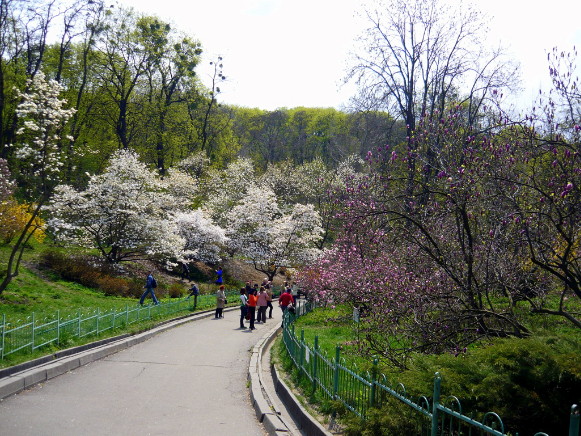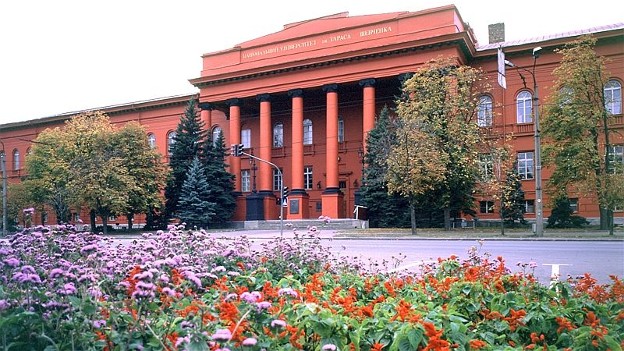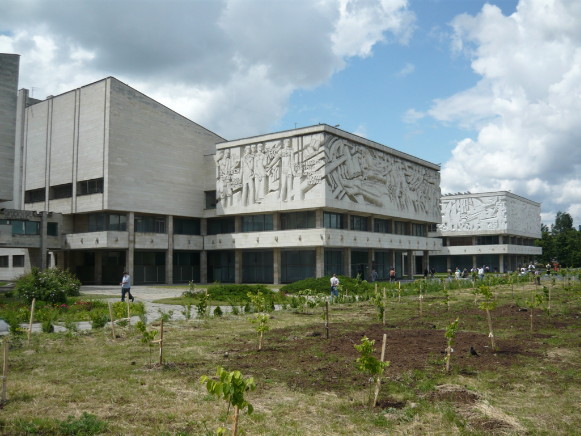Kyiv National University
Kyiv National University (Київський національний університет імені Тараса Шевченка; Kyivskyi natsionalnyi universytet imeni Tarasa Shevchenka). Higher educational institution in Kyiv, one of the oldest and most important scholarly and cultural centers in Ukraine.
Opened in 1834, it was the second university (after Kharkiv University) to be established in Russian-ruled Ukraine. Several requests from the local nobility for a university in Kyiv, dating back to 1765, were turned down by the Russian imperial government that until 1831 accepted the dominance of Polish culture in Right-Bank Ukraine and in 1803 even had established a Polish school system there under the supervision of Vilnius University. The Polish Insurrection of 1830–1 convinced Nicholas I that Right-Bank Ukraine had to be Russified, and to accomplish this the existing school system had to be replaced with a Russian one supervised from Kyiv. Thus, Kyiv University was established to oversee the new educational system. It inherited the library, collections, and faculty of the Kremianets Lyceum, a Polish higher school that was closed down following the insurrection. The university was named after ‘Saint Vladimir’ (Volodymyr the Great) and consisted, initially, of only one faculty—the philosophy faculty—which was subdivided into two departments—history and philology, and physics and mathematics. The following year the law faculty was added. The four-year program was designed to give a general, not a specialized, education. The university’s autonomy was restricted: professors and faculty deans selected by the Professorial Council had to be approved by the minister of education; the elected rector had to be approved by the tsar; and the appointed curator of the school district kept a close watch over university affairs. Through a special school committee the university supervised all schools in its school district until 1835. The first rector was a Ukrainian scholar, Mykhailo Maksymovych, but most of the professors were Poles. Of the 62 original students, 34 were Catholics, mostly Poles and some Uniates. Until the 1860s Poles from Right-Bank Ukraine formed the majority of the student body, followed by Ukrainians from Left-Bank Ukraine.
Although the university was intended to be an instrument of Russification, it became a center of revolutionary activity and national awakening. In 1838 a clandestine student society, a branch of the Union of the Polish People, was uncovered in Kyiv. Many professors and students were expelled and the university was closed for half a year. New faculty were recruited from among the German graduates of Dorpat University and the reduced student body was placed under stricter surveillance. In 1841 a faculty of medicine, formed out of the abolished Vilnius Medico-Surgical Academy, was added. In the following year enrollment rose to its 1838 level (ca 260). At the end of 1845 Mykola Kostomarov, the professor of Russian history at Kyiv University, founded the clandestine Cyril and Methodius Brotherhood. The Russian government reacted to the revolutionary unrest in Central and Western Europe in 1848 by imposing new restrictions on the university: the rector and deans were appointed by the minister of education and approved by the tsar; lectures had to conform to a prescribed program and were monitored by the rector; the philosophy faculty was abolished; foreign scholars were denied teaching positions and Russian scholars were barred from studying abroad; and the enrollment of self-supporting students (excluding medical students) was restricted to 300. Student fees were doubled, while faculty salaries were cut. These measures had a disastrous effect on the quality of research and teaching at the university. Many chairs remained vacant, and many professors turned to outside work to supplement their income. The situation began to improve only at the end of the 1850s when the new tsar, Alexander II, assumed a more liberal policy.
As restrictions on the freedom of association were lifted, students and faculty became involved in social issues. In 1859 a group of Kyiv students, including Mykhailo Drahomanov, organized Sunday schools for workers and peasants, in which the Ukrainian language was used for the first time as the language of instruction. Two years later a number of students with a populist outlook (see Khlopoman), including Volodymyr Antonovych, joined the group and formed the first clandestine Hromada of Kyiv. The university reform of 1863 was intended to avoid the kind of student unrest that broke out in 1861. Universities were granted greater control of their curricula, research, and administration. Rectors, deans, and professors were again elected by the professorial councils. For the first time Kyiv University was included under the general statute governing universities. In the next two decades the university expanded slowly but steadily. New chairs were established and the faculty expanded from 49 in 1863 to 66 in 1884. The number of works published by faculty members increased dramatically. The school’s official monthly Universitetskie izvestiia began to appear (1861–1919). In spite of its social liberalism, the new regime disapproved of the fledgling Ukrainophile movement: in 1862 the Sunday schools were suppressed and in the following year the student hromada was disbanded. The Polish Insurrection of 1863–4 led to the expulsion of many Polish students from the university. Increasing political activity among university students aroused grave concern in government circles. New repressions against Ukrainians in the mid-1870s included Drahomanov’s dismissal from his teaching position.
Following the assassination of Tsar Alexander II, a new statute adopted in 1884 sharply reduced the autonomy of universities. The minister of education assumed the right to appoint rectors, deans, and professors. State funds for universities were reduced, while student fees were raised. Student organizations and meetings were banned. In Kyiv the new law provoked demonstrations, which led to the closing of the university for half a year. The general student strike in 1899 was supported by Kyiv students. In 1900, 183 students of Kyiv University were conscripted into the army as punishment for their participation in demonstrations. By 1905 the authorities realized that the 1884 university statute had to be replaced by a more liberal one. A number of drafts were prepared by successive education ministers, but none were signed into law. Although enrollment jumped from 2,313 in 1895 to 5,107 in 1910, the faculty grew only from 118 (in 1894) to 166 (in 1913) and the number of chairs did not change.
By the 20th century, Kyiv University had established itself as one of the leading universities within the Russian Empire. It ran over 50 auxiliary facilities: 2 libraries, the Kyiv Astronomical Observatory, a meteorological observatory, a botanical garden, various laboratories, cabinets, and 9 clinics. Its faculty included many prominent scholars, such as the historians Mykola Kostomarov, Mykhailo Drahomanov, Volodymyr Antonovych, Mytrofan Dovnar-Zapolsky, and Ivan Luchytsky; the literary scholar Mykola Dashkevych; the philologist Volodymyr Peretts; the jurist Oleksander Kistiakovsky; the economist Nikolai Bunge; the chemist Sergei Reformatsky; the physicists Mikhail Avenarius and Yosyf Kosonohov; the mathematicians Boris Bukreev and Dmytro Grave; the zoologists Aleksandr Kovalevsky and Aleksei Severtsov; the biologist S. Navashin; the anatomist Volodymyr Bets; and the pathologists Grigorii Minkh, Volodymyr Pidvysotsky, and Volodymyr Vysokovych. Some of these professors were graduates of Kyiv University. A number of learned societies were affiliated with the university: the Kyiv Society of Naturalists (est 1869), the Historical Society of Nestor the Chronicler (est 1873), the Kyiv Juridical Society (est 1877), the Kyiv Midwifery and Gynecology Society (est 1885), the Kyiv Physics and Mathematics Society (est 1890), the Kyiv Physico-Medical Society (est 1896), and the Kyiv Physics and Chemistry Society (est 1910).
In spite of the participation of many of the university’s students, graduates, and faculty members in the Ukrainian national movement, Kyiv University was reluctant, especially in the early twentieth century, to incorporate Ukrainian studies in its curriculum. The university leadership and part of the faculty, particularly Timofii Florinsky, were hostile to the Ukrainian movement. During the Revolution of 1905 Ukrainian students demanded four chairs with the Ukrainian language as the language of instruction, and a year later the university itself requested two such chairs, but nothing came of these efforts. In 1907 Andrii Loboda and Volodymyr Peretts decided to give their lectures in Ukrainian, but were forbidden to continue. It was only in September 1917 that limited use of Ukrainian at Kyiv University was permitted. The Provisional Government approved its use as the language of instruction by four new chairs in Ukrainian studies: the chairs of literature, Ukrainian language, the history of Ukraine, and the history of Western Ruthenian law. During Ukraine’s struggle for independence (1917–20), under the changing regimes, the normal activities of the university were hampered by political interference and inadequate funding. In accordance with Hetman Pavlo Skoropadsky’s Ukrainization policy, Kyiv (or Saint Vladimir) University was preserved as a Russian institution and a separate Ukrainian State University was established. In 1919 the Bolshevik authorities merged a number of institutes, higher schools for women, and the new Ukrainian university with the old university, which they renamed Kyiv State University.
In 1920 the Soviet regime began a radical restructuring of Ukraine’s educational system. The universities were replaced by institutes of people's education and Kyiv University was reorganized into the Kyiv Institute of People's Education and the Kyiv Institute of Health Care (later Kyiv Medical Institute). These institutes were Ukrainized rapidly. In 1933 Kyiv University was restored under the name Kyiv State University (KDU), through the merger of Kyiv Institute of Professional Education and Kyiv Physical-Chemical-Mathematical Institute. The university consisted of six faculties: physics and mathematics, chemistry, biology, geology and geography, history, and literature and language. In 1937 two new faculties were opened: law and Western languages and literatures. In 1939 the university was named in honor of Taras Shevchenko. In the following year the physics and mathematics faculty was split into the mechanics and mathematics faculty and the physics faculty. Enrollment rose rapidly in the 1930s from 1,650 (1933) to 3,700 (1939). In spite of increasing funding and improved facilities, academic achievement was low because of countless political meetings, frequent revisions of the curriculum, and widespread purges that decimated universities in the 1930s, beginning with the show trial of the Union for the Liberation of Ukraine in 1929–30 and culminating in the great terror of the mid-1930s. KDU suffered an especially heavy damage during these years. By some estimates, up to 80 percent of its faculty, including several rectors, were subjected to some form of persecution between 1933 and 1941. Among those who were executed was mathematician Mykhailo Kravchuk; literary scholars Mykola Zerov, Pavlo Fylypovych, and Makar Rusanivsky; historians Yosyf Hermaize and Natalia Mirza-Avakiants; and orientalist Ahatanhel Krymsky.
During the Second World War the university was evacuated to Kzyl-Orda in Kazakhstan, where it was amalgamated with Kharkiv University to form the Unified Ukrainian State University (1941–3). A minority of faculty members remained in Nazi-occupied Kyiv and were permitted to work in the reopened Kyiv University (1941–2) under the rectorship of historian Kostiantyn Shteppa. The university suffered heavily at the hands of the retreating Nazis: its iconic Red Building was severely damaged, while its library, museum collections, and laboratories were plundered. When it was reopened in Kyiv in January 1944, the university consisted of 13 faculties and had an enrollment of 2,560. A strong emphasis was placed on making the university more responsive to the demands of industrial development. During the first two postwar decades KDU saw a few major changes and additions, among them a new building of the Kyiv Astronomical Observatory, the zoological museum in the reconstructed main building (both in 1951), a new faculty of radio physics, followed by the faculty of journalism (both in 1953), and the computation center (1956). By 1958 KDU had eleven faculties and 11,000 students. In 1969 one of the pioneering faculties of cybernetics in the USSR was opened at KDU. These years also saw the construction of a modern campus consisting of a dozen new teaching and living facilities that today house the faculties of natural and hard sciences, as well as the faculty of economy (the new complex was designed by Vadym Ladny, V. Kolomiiets, and V. Drizo in the early 1950s and completed largely by the late 1970s). By the mid-1980s KDU was by far the largest university in Ukraine by student enrollment (18,000), followed by Dnipropetrovsk University with 13,000 students. Between 1959 and 1984 KDU trained 70,000 graduates in the variety of disciplines.
Under the leadership of its longest-serving rector Viktor Skopenko (1985–2008 in office), the university underwent an unprecedented transformation in the late 1980s and early 1990s, which mirrored the dramatic political, social, and cultural changes that led to the creation of independent Ukraine in 1991. Among numerous internal changes during those years was the opening of the institute of international relations and international law (1988); the faculty of sociology and psychology (1991); the institute (today center) of Ukrainian studies (1991); the institute of journalism (transformed from the faculty of journalism in 1993); and the institute of management and finances (1996). In 1994 KDU was granted the status of a national institution of higher learning, and it assumed its current name: Kyiv National University (KNU). KNU’s unique standing as an autonomous and self-governing institution was further expanded with a number of fiscal and academic privileges granted by President Viktor Yushchenko and the Cabinet of Ministers of Ukraine in 2008–9. Still earlier, in 1999, its rector acquired a status equal to that of a minister. The same year KNU signed an agreement of collaboration with the National Academy of Sciences of Ukraine, which strengthened the university’s role in promoting the basic research. The new university statute was issued in 2004 (updated in 2017), in which KNU was defined as ‘the multisectoral classical [and] leading institution of higher education in Ukraine, the national heritage in education, culture, and scholarship.’
Today KNU is one of the most prestigious higher educational institutions in Ukraine. It has been consistently ranked as the nation’s top university. For instance, in 2021 it was ranked first in the Consolidated Ranking of all Ukrainian universities conducted by the influential educational web portal Osvita.ua. In the same ranking it was also featured as the best ‘classical’ university in Ukraine. It was ranked highest (601st) of all other Ukrainian universities in the prestigious QS World University Rankings in 2021. The KNU student enrollment is approximately 26,000 undergraduate and close to 1,800 graduate students. The university encompasses 12 faculties: geography; economics; history; mechanics and mathematics; information technologies; computer sciences and cybernetics; psychology; radio physics, electronics, and computer systems; sociology; physics; philosophy; and chemistry—as well as 11 educational and scientific research institutes—military studies; high technologies; journalism; international relations; continuous education; law; administration of state security of Ukraine; philology; geology; public administration and government service; and biology and medicine. There are also several centers combining education and research in such diverse fields as radiation security; Ukrainian studies; recreation and tourism; and foreign languages. It also operates a college of geological prospecting; a college of optics and mechanics; and a lyceum of physics and mathematics. In addition to faculties and institutes, KNU manages Kyiv Astronomical Observatory (founded in 1845), a botanical garden (founded in 1839), zoological museum (founded in 1834), geological museum (founded in 1834 as a mineralogical cabinet), archeological museum, and Kaniv Nature Reserve (founded in 1923). KNU’s scholarly library, named after its first rector Mykhailo Maksymovych, is one of the oldest academic libraries in Ukraine (opened in 1834). It was based on the valuable collection of the Kremenets Lyceum (34,378 volumes) and was continuously expanded over the years. It now has 3.5 million volumes, including 7,000 rare old books and incunabula written in Latin, Greek, Biblical Hebrew, Church Slavonic, Old Ukrainian, and other languages. Another notable collection includes the most comprehensive selection of works by Kyiv University’s scholars dating back to 1834 (circa 16,000 volumes).
Kyiv University has published the journals Naukovi zapysky (1935–49) and Visnyk Kyïvs'koho universytetu (since 1957, currently in seventeen series) and the newspaper Kyïvs'kyi universytet. In addition, it publishes two dozen other more specialised periodicals, among them Humanitarni studiї (31 vols, 2007–18), Aktual'ni problemy mizhnarodnykh vidnosyn (139 vols, 1997–), Aktual'ni problemy sotsiolohiї, psykholohiї, pedahohiky (43 vols, 2003–), Advances in Astronomy and Space Physics (10 vols, 2011–), Zhurnal ievropeis'koho i porivnial'noho prava (12 vols, 2016–), Zhurnal obchysliuval'noї ta prykladnoї matematyky (1965–), Teoretychni ta prykladni pytannia ekonomiky (41 vols, 2003–), Mizhnarodni vidnosyny. Seriia: Politychni nauky (22 vols, 2013–), Mizhnarodni vidnosyny. Seriia: Ekonomichni nauky (25 vols, 2013–), Hidrolohiia, hidrokhimiia i hidroekolohiia (34 vols, 2000–14), Ekonomichna ta sotsial'na heohrafiia (85 vols, 1966–), Bankivs'ka sprava (1995–), Administratyvne pravo i protses (30 vols, 2012–), and French-Ukrainian Journal of Chemistry (9 vols, 2013–).
During the Soviet period the faculty of Kyiv University included many noted scholars, such as linguists Leonid Bulakhovsky, Mykola Hrunsky, and Pavlo Pliushch; literary scholar Oleksander Biletsky; pedagogue Mykyta Hryshchenko; psychologist Hryhorii Kostiuk; economist Kostiantyn Vobly; biologists D. Protsenko, Dmytro Zerov, and Oleksander P. Markevych; physicists Vadym Lashkarov and Sergei Vsekhsviatsky; geologists Borys Chernyshov and Volodymyr Luchytsky; and mathematician Viktor Hlushkov.
The main building of the university complex was built in 1837–42 by Vincent Beretti. Along with other buildings, it was heavily damaged during the Second World War, and was restored afterwards.
BIBLIOGRAPHY
Vladimirskii-Budanov, M. Istoriia Imperatorskogo universiteta sv. Vladimira (Kyiv 1884)
Zhmuds'kyi, O. (ed). Istoriia Kyïvs'koho universytetu (Kyiv 1959)
Kyïvs'kyi universytet za 50 rokiv radians'koï vlady (Kyiv 1967)
Belyi, M., et al (eds). Kievskii universitet. Dokumenty i materialy, 1834–1984 (Kyiv 1984)
Z imenem sviatoho Volodymyra: Kyїvs'kyi universytet u dokumentakh, materialakh ta spohadakh suchasnykiv, 2 vols (Kyiv 1994)
Istoriia Kyïvs'koho universytetu: Monohrafiia (Kyiv 2014)
Serhiy Bilenky, Bohdan Struminsky, Taras Zakydalsky
[This article was updated in 2021.]
 University (19th century).jpg)
.jpg)
.jpg)



.jpg)